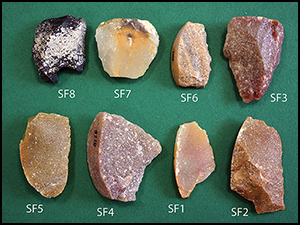Crossref Citations
This article has been cited by the following publications. This list is generated based on data provided by
Crossref.
Wang, Jiajing
Zhao, Xueye
Wang, Hui
and
Liu, Li
2019.
Plant exploitation of the first farmers in Northwest China: Microbotanical evidence from Dadiwan.
Quaternary International,
Vol. 529,
Issue. ,
p.
3.
Xie, Liye
Gallo, Tiziana
and
Macdonald, Danielle
2019.
Microwear analysis on experimental ground stone earth-working implements and its implication for investigating ancient agricultural practices.
Journal of Archaeological Science: Reports,
Vol. 25,
Issue. ,
p.
351.
Li, Weiya
Tsoraki, Christina
Lan, Wanli
Yang, Yuzhang
Zhang, Juzhong
and
van Gijn, Annelou
2019.
New insights into the grinding tools used by the earliest farmers in the central plain of China.
Quaternary International,
Vol. 529,
Issue. ,
p.
10.
Song, Yanhua
2019.
Encyclopedia of Global Archaeology.
p.
1.
2019.
ANNUAL BIBLIOGRAPHY.
Early China,
Vol. 42,
Issue. ,
p.
347.
Lee, Gyoung-Ah
Cho, Mi-soon
and
Obata, Hiroki
2019.
Coastal farmers during the Early and Middle Holocene: Archaeobotanical and grain impression studies on the east coast Korea.
Quaternary International,
Vol. 529,
Issue. ,
p.
57.
Song, Yanbo
Sun, Bo
Gao, Yaqi
and
Yi, Hailin
2019.
The environment and subsistence in the lower reaches of the Yellow River around 10,000 BP ——faunal evidence from the bianbiandong cave site in Shandong Province, China.
Quaternary International,
Vol. 521,
Issue. ,
p.
35.
Song, Yanhua
Grimaldi, Stefano
Santaniello, Fabio
Cohen, David J.
Shi, Jinming
Bar-Yosef, Ofer
and
Petraglia, Michael D.
2019.
Re-thinking the evolution of microblade technology in East Asia: Techno-functional understanding of the lithic assemblage from Shizitan 29 (Shanxi, China).
PLOS ONE,
Vol. 14,
Issue. 2,
p.
e0212643.
Duncan, Neil A.
Starbuck, John
and
Liu, Li
2019.
A method to identify Job's tears, Coix lacryma-jobi L., phytoliths in northern China.
Journal of Archaeological Science: Reports,
Vol. 24,
Issue. ,
p.
16.
Levin, Maureece J.
Wang, Jiajing
and
Liu, Li
2019.
From foraging to farming across the Asia-Pacific: An introduction.
Quaternary International,
Vol. 529,
Issue. ,
p.
1.
Li, Weiya
Tsoraki, Christina
Lan, Wanli
Yang, Yuzhang
Zhang, Juzhong
and
van Gijn, Annelou
2019.
Cereal processing technique inferred from use-wear analysis at the Neolithic site of Jiahu, Central China.
Journal of Archaeological Science: Reports,
Vol. 23,
Issue. ,
p.
939.
Liu, Li
Duncan, Neil A.
Chen, Xingcan
and
Cui, Jianxin
2019.
Exploitation of job's tears in Paleolithic and Neolithic China: Methodological problems and solutions.
Quaternary International,
Vol. 529,
Issue. ,
p.
25.
Liu, Li
Wang, Jiajing
Levin, Maureece J.
Sinnott-Armstrong, Nasa
Zhao, Hao
Zhao, Yanan
Shao, Jing
Di, Nan
and
Zhang, Tian’en
2019.
The origins of specialized pottery and diverse alcohol fermentation techniques in Early Neolithic China.
Proceedings of the National Academy of Sciences,
Vol. 116,
Issue. 26,
p.
12767.
Dong, Guanghui
Li, Ruo
Lu, Minxia
Zhang, Dongju
and
James, Nathaniel
2020.
Evolution of human–environmental interactions in China from the Late Paleolithic to the Bronze Age.
Progress in Physical Geography: Earth and Environment,
Vol. 44,
Issue. 2,
p.
233.
Song, Yanhua
2020.
Encyclopedia of Global Archaeology.
p.
9703.
Ge, Yong
Lu, Houyuan
Zhang, Jianping
Wang, Can
and
Gao, Xing
2020.
Phytoliths in Inflorescence Bracts: Preliminary Results of an Investigation on Common Panicoideae Plants in China.
Frontiers in Plant Science,
Vol. 10,
Issue. ,
Zhang, Meng
2020.
Microblade–Based Societies in North China at the End of the Ice Age.
Quaternary,
Vol. 3,
Issue. 3,
p.
20.
Miras, Yannick
Barbier-Pain, Delphine
Ejarque, Ana
Allain, Elisabeth
Allué, Ethel
Marín, Juan
Vettese, Delphine
Hardy, Bruce
Puaud, Simon
Mangado Llach, Javier
and
Moncel, Marie-Hélène
2020.
Neanderthal plant use and stone tool function investigated through non-pollen palynomorphs analyses and pollen washes in the Abri du Maras, South-East France.
Journal of Archaeological Science: Reports,
Vol. 33,
Issue. ,
p.
102569.
Li, W.
Pagán‐Jiménez, J. R.
Tsoraki, C.
Yao, L.
and
Van Gijn, A.
2020.
Influence of grinding on the preservation of starch grains from rice.
Archaeometry,
Vol. 62,
Issue. 1,
p.
157.
Fullagar, Richard
Hayes, Elspeth
Chen, Xingcan
Ma, Xiaolin
and
Liu, Li
2021.
A functional study of denticulate sickles and knives, ground stone tools from the early Neolithic Peiligang culture, China.
Archaeological Research in Asia,
Vol. 26,
Issue. ,
p.
100265.
